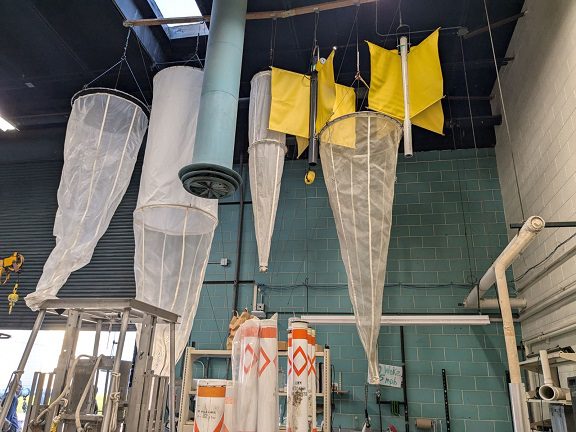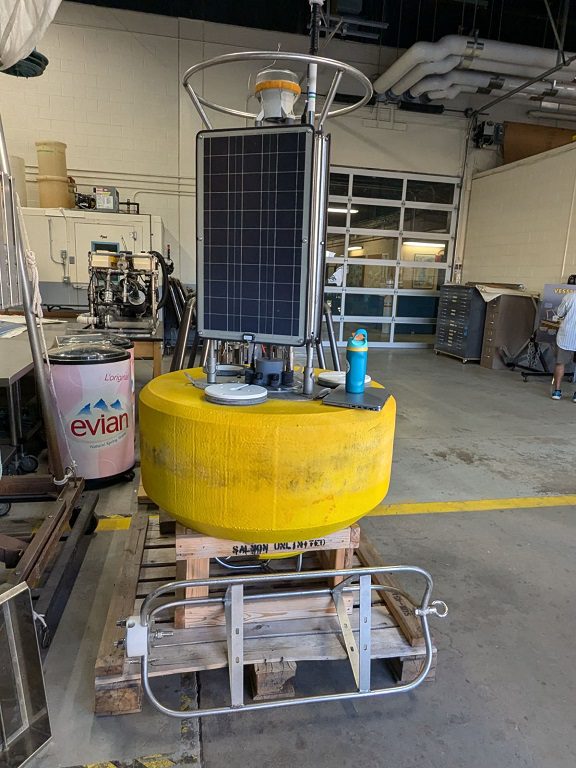By James Heinz
On October 3, 2024, I and 24 other members of the Wisconsin Marine Historical Society met for a tour of the UW Milwaukee School of Freshwater Sciences (SFS) 600 East Greenfield Avenue, Milwaukee.

UW Milwaukee School of Freshwater Sciences
Members who attended included myself, former WMHS president Carl Eisenberg, current WMHS president Todd Gordon and his wife, Soundings editor Kathie Gordon, legendary shipwreck hunter Steve Radovan, Milwaukee Public Library director Joan Johnson, and members Jan Hetzel, Bob Melzer, Nancy Carpenter, and other valued members.
SFS’s website describes itself as “The School of Freshwater Sciences offers bachelors, masters, accelerated masters and doctoral degree programs in freshwater sciences and atmospheric science. Our scientists study everything from aquaculture to emerging contaminants, from ecosystem health to weather forecasting and climate change projections.”

Plankton nets
We were greeted by Outreach director Liz Sutton. Liz explained that the Great Lakes holds 20% of the world’s fresh water, while 97% of the water on Earth is salty. The Great Lakes area economy is the third largest economy on Earth.

Lake data buoy
Liz explained that SFS has about 200 students on 5 separate career tracks in atmospheric and aquatic studies. From the point of view of those students, the most important statistic may be that SFS boasts a 95% job placement rate for those who graduate.


Remotely operated vehicle aka ROV
Liz explained some of the important work that SFS does:
SFS monitors human sewage for COVID, flu, and RSV viruses and prescription medication levels. SFS conducts experiments in aquaculture, raising sturgeon, walleye, tilapia, and yellow perch. SFS mapped fish habitat in Milwaukee harbor https://uwm.edu/harbormaps/ that many thought were barren of life. SFS discovered that the lagoon at Summerfest is a fish nursery for the entire harbor.
SFS addressed the issue of frequent closings of Bradford beach due to high levels of e-coli from in the water in two ways. Bird droppings were reduced when Milwaukee County Parks hired people to walk their dogs along the beach, scaring the birds away.
E-coli was found to be leaking from pipes on top of the bluff overlooking the beach. SFS suggested building a bioswale at the foot of the bluff that intercepts the human e-coli and directs it into a pipe at the bottom of the garden that then drains into the sewer system.

Bottom core sampler
Liz said that the introduction of the zebra and quagga mussels has been the biggest change in the Great Lakes ecosystem. Each thumbnail sized mussel filters a liter of water per day. That means all of the water in the Lakes passes through the mussels every 7-10 days.
The mussels clear the water column, which can have good and bad effects. As someone who started scuba diving in the 1970s when the visibility was so bad we called it “braille diving”, I can attest that the Lake is much clearer.
The filtering of all the micro-organisms in the water makes it unlikely that the dreaded Asian carp will successfully reproduce in the Lakes, since the clear water leaves nothing for them to eat. Also, the carp like warm, shallow waters, which the Great Lakes are not.
On the other hand, the clearing of the water column makes it unlikely that the famous yellow perch will ever return. Only 12 percent of yellow perch hatchlings survive more than 100 days in the Lakes.
As for the disappearance of the famous smelt, no one is making efforts to return them to our waters, because the smelt were also an invasive species.
Finally, we separated into two groups to tour the facility. Although most of the building is classrooms and laboratories, the loading dock area along the dock on the north side contains some of the equipment that the scientists use.
____________________________________
James Heinz is the Wisconsin Marine Historical Society’s acquisitions director. He became interested in maritime history as a kid watching Jacques Cousteau’s adventures on TV. He was a Great Lakes wreck diver until three episodes of the bends forced him to retire from diving. He was a University of Wisconsin – Milwaukee police officer for thirty years. He regularly flies either a Cessna 152 or 172.
Photos by James Heinz

